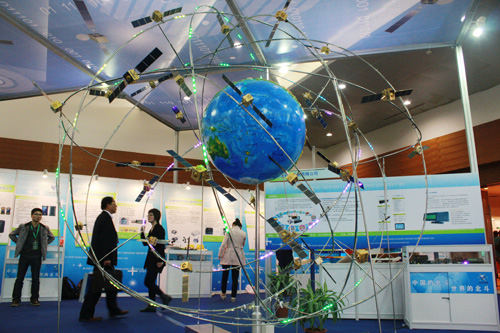|
 |
|
GLOBAL POSITIONING: A model of the Beidou Satellite Navigation system is displayed at a hi-tech exhibition in Shanghai on November 1 (ZHANG JIANSONG) |
People in Shanghai will be able to enjoy a more convenient and efficient public transport by using their smart phones to search for the nearest bus or even taxi. Transport infrastructure, such as bus stops, could also be equipped with Beidou use, said Shen.
"Beidou has the equivalent performance of other positioning systems like GPS in terms of some key functions. Its precision with regards to position will be further improved as the project develops," said Sun. "In the near future, Beidou will have its uses in transportation, tourism and public services."
The first satellite
Aside from the Beidou satellite positioning system, Sun has been a pioneer of most of China's satellites and space exploration projects over the past half century and has dedicated his life to China's aerospace industry.
"I spent seven years studying airplane design, nine years on missiles, and 40 more years on launching satellites," he said. China created and launched over 100 satellites and spacecraft over the past four decades. One third of them were attributed to Sun's work.
To this silver-haired scientist, the most memorable experience is China's first satellite launch in 1970.
"It is easy to launch a satellite thanks to China's current aerospace science and technology. But in the late 1960s, we didn't even have a 21-core plug," recalled Sun.
At that time China was prevented from possessing high technology during the Cold War. Moreover, the "cultural revolution" (1966-76) seriously impacted the aerospace industry and most research was suspended.
Despite the major setbacks, the Chinese Government vowed to launch its first satellite by 1970. The first satellite was considered more a political success than a scientific one, an attempt for China to show the world that it had grasped satellite technology.
Qian Xuesen (1911-2009), a leading mind in rocket technology, was presiding over major aerospace projects in the middle of the last century when he appointed Sun to organize a research team to develop the country's first satellite. With a team of 18 scientists, Sun developed the prototype Dongfanghong-1 in October 1969.
But there was a problem.
Researchers hoped that the public could see the satellite live with their own eyes.
Sun and his team tried different ways to light up the surface of the satellite in order to make it visible, but to no avail: The team realized that no matter how they lit up the satellite, it was indistinct to the naked eye.
One member of the team suggested the answer lay in the third and final stage of the rocket, upon which the satellite rested. Sun and his colleagues designed a balloon coated with aluminum and attached it to the third stage. When the satellite was launched into orbit, the rocket's final stage would fly in tandem with the satellite. The balloon would be easy to spot.
But, as Sun stressed, "We had to tell people that what they saw was the balloon, and the satellite is near the balloon."
On April 24, 1970, China's first satellite Dongfanghong-1 was launched into space. Thousands of people gathered at Beijing's Tiananmen Square to watch as the Dongfanghong-1 flew over.
In the ensuing decades, Sun designed numerous space projects, many of which are milestones for Chinese aerospace science and technology, including moon exploration.
Today, Sun is still at it.
"What I need to do now is to cultivate more researchers and scientists for the future of China's aerospace development. I hope I can do that," he said.
Who is Sun Jiadong?
1929: Born in Gaixian County, Liaoning Province
1958: Graduated from Zhukovsky Central Aero-hydrodynamic Institute in the former Soviet Union, majoring in airplane design
1985: Elected as a member of International Academy of Astronautics
1991: Became an academician of Chinese Academy of Sciences
1999: Bestowed the highest national honor for his contributions in developing China's first atomic bomb, hydrogen bomb and space satellite
2009: Won the State Science and Technology Top Awards
Email us at: tangyuankai@bjreview.com | 